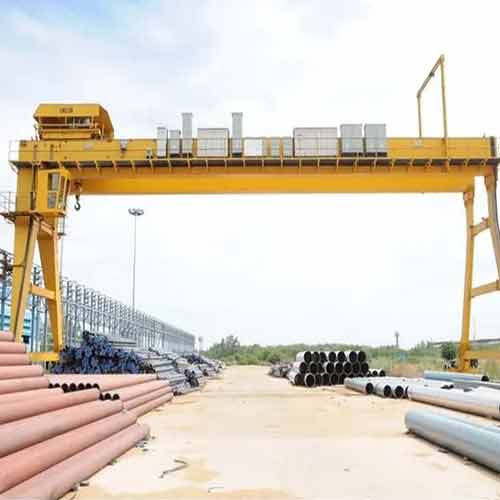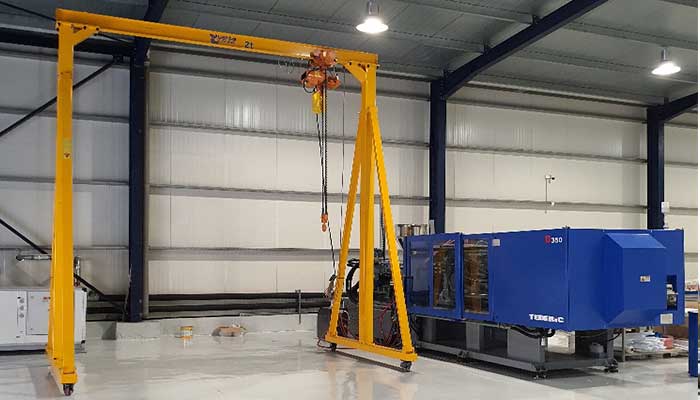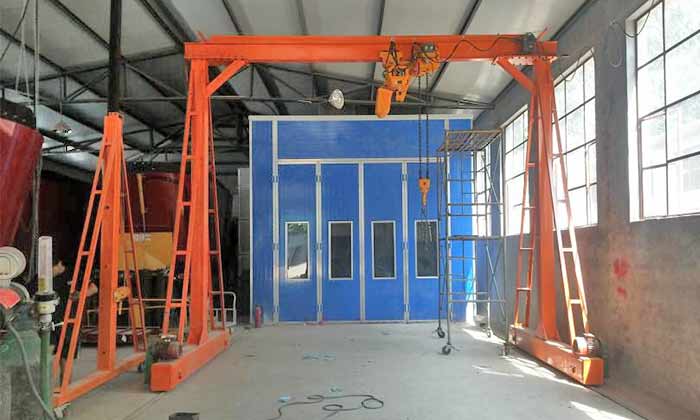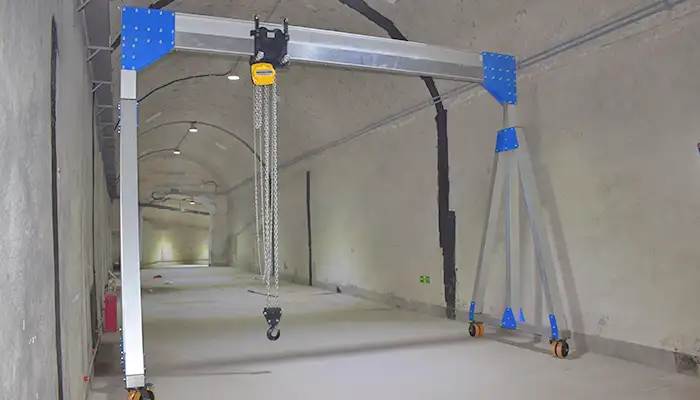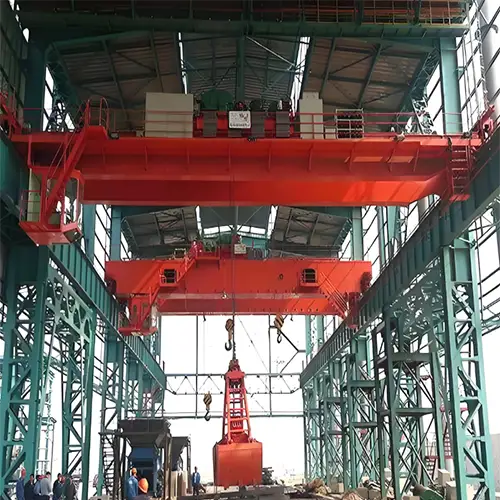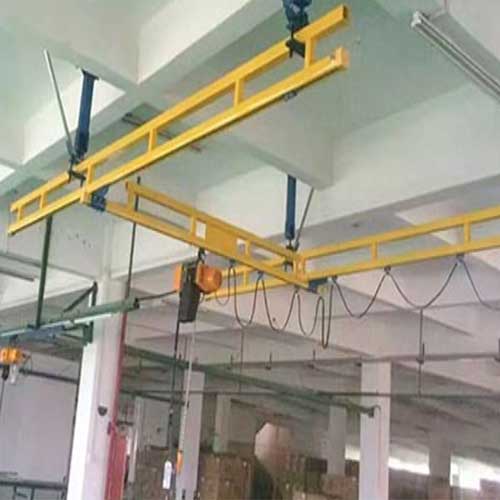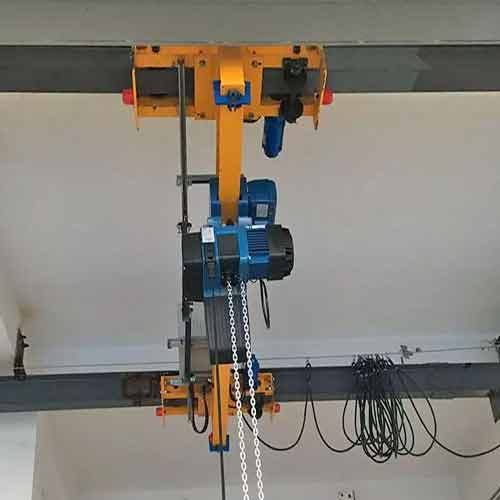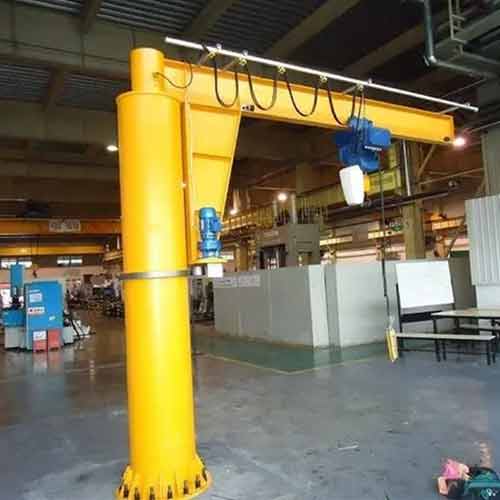Overhead Gantry Crane System | Indoor & Outdoor Gantry System
Overhead gantry crane for sale, custom overhead gantry system, overhead hoist gantry system & open gantry system for indoor & outdoor material handling.
| Crane type | Overhead Gantry Crane System |
| Single girder gantry system | 1 ton to 20 ton |
| Double girder gantry system | 3 ton -320 ton |
| Portable gantry system | 0.25 ton - 10 Ton |
Category: Crane System
Your Trusted Overhead Gantry Crane Manufacturer & Supplier
Overhead Gantry Crane System , Indoor & Outdoor Gantry Systems
Overhead Hoist Gantry System & Open Gantry System 3 Ton, 5 Ton, 10 Ton up to 100 Ton for Your Needs
Overhead gantry crane for sale, custom overhead gantry system, overhead hoist gantry system & open gantry system for indoor & outdoor material handling.
Overhead gantry cranes, often referred to simply as gantry cranes, are indispensable pieces of equipment used for lifting and moving heavy loads within a defined workspace. These cranes are designed to provide a versatile and efficient solution for material handling, making them a common sight in various industries, including manufacturing, construction, and logistics. Unlike traditional cranes that rely on vertical supports, gantry cranes are equipped with horizontal girders that span the width of the workspace, enabling them to carry out lifting tasks with precision and ease. Gantry cranes come in various configurations to accommodate different load capacities and operational requirements, and their adaptability makes them a valuable asset in numerous work environments.
Importance of Overhead Gantry Cranes
The importance of overhead gantry cranes cannot be overstated, especially in industries where the swift and secure movement of heavy items is crucial. These cranes offer several key benefits, such as:
- Efficiency: Overhead gantry cranes are renowned for their efficiency in moving heavy loads. They can quickly transport items from one location to another, reducing the time and effort required for manual handling.
- Safety: Gantry cranes are designed with safety in min They are equipped with various safety features and mechanisms to ensure the protection of both workers and the loads they handle.
- Versatility: These cranes can be tailored to suit the unique needs of different industries. Whether you're working in a manufacturing facility, a shipyard, or a construction site, there is likely a gantry crane configuration that fits your requirements.
- Cost Savings: Gantry cranes help reduce labor costs and minimize the risk of accidents or damage to goods, ultimately saving businesses money in the long run.
In this comprehensive guide, we will delve into the world of overhead gantry cranes, leaving no stone unturne Our journey will take us through an exploration of the various types of gantry cranes, a deep dive into their key features and components, a discussion of reputable manufacturers, insights into pricing considerations, and an examination of gantry crane systems. We'll also provide valuable information about hoists, which are essential components of these cranes, and the benefits of expanding your system with multiple cranes. Additionally, we will discuss maintenance and safety guidelines that are essential for both current users and prospective buyers of overhead gantry cranes. So, if you're looking to enhance your understanding of these remarkable machines or considering investing in one for your operation, stay with us to discover everything you need to know about overhead gantry cranes.
Types of Overhead Gantry Cranes
Overhead gantry cranes come in various configurations to cater to diverse industrial needs. Understanding the different types of gantry cranes is essential in choosing the right one for your specific application. Here, we'll explore the primary categories of overhead gantry cranes:
Single Girder vs. Double Girder Overhead Gantry Cranes
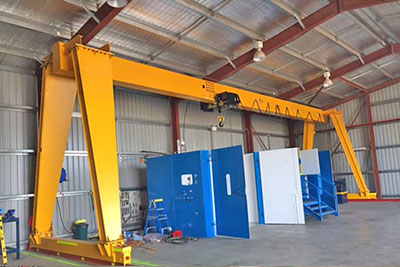
- Description: Single girder gantry cranes feature a single horizontal girder running parallel to the groun This design offers cost-effectiveness and versatility, making them suitable for light to moderate lifting tasks.
- Ideal for: Single girder gantry cranes are commonly used in manufacturing plants, warehouses, and maintenance shops where precision and efficiency are paramount.
- Benefits: These cranes are compact, easy to install, and require minimal structural support. They are suitable for operations with limited headroom.
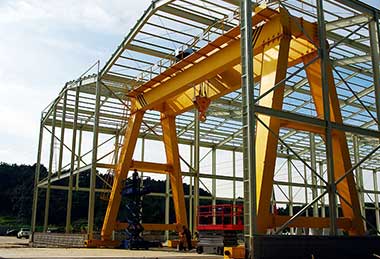
- Description: Double girder gantry cranes have two horizontal girders that provide increased load capacity and stability. They are designed to handle heavier loads compared to their single girder counterparts.
- Ideal for: Industries with heavy lifting requirements, such as steel mills, shipyards, and construction sites, often use double girder gantry cranes.
- Benefits: The dual girder design allows for high lifting heights and the capability to move massive loads efficiently. They are a robust choice for demanding applications.
Semi-Gantry Cranes vs. Full Gantry Cranes
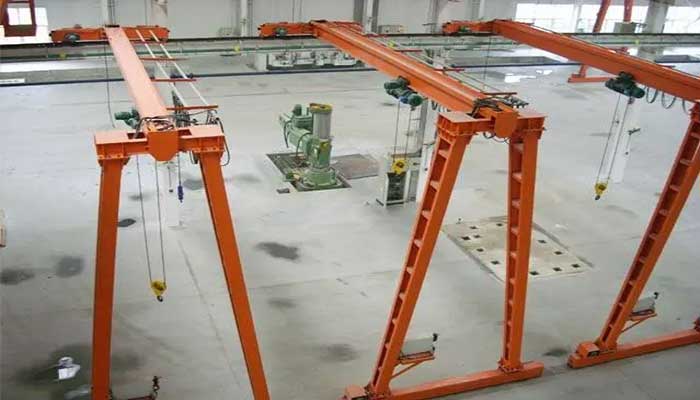
- Description: Semi-gantry cranes are supported by a single leg on one side, while the other side travels on an overhead runway. This configuration is ideal for facilities with space limitations and uneven groun
- Ideal for: Semi-gantry cranes are often employed in outdoor storage yards, shipyards, and loading docks, where mobility and adaptability are essential.
- Benefits: Their one-sided support allows semi-gantry cranes to traverse uneven terrain, making them a valuable asset in outdoor and semi-open environments.
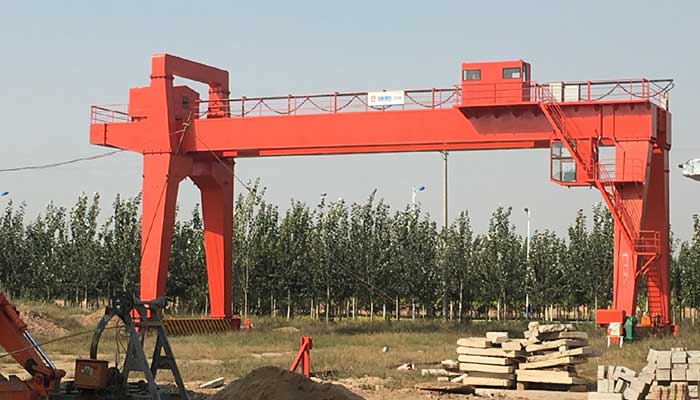
- Description: Full gantry cranes are fully supported by legs on both sides, providing maximum stability and load-bearing capacity. They are often used in large indoor spaces.
- Ideal for: Full gantry cranes are suitable for applications requiring precision and consistency, such as manufacturing and assembly lines.
- Benefits: These cranes offer exceptional load-bearing capabilities and are known for their stability, making them an excellent choice for high-precision tasks.
Overhead indoor gantry crane and outdoor gantry crane
Overhead gantry cranes can be categorized into indoor and outdoor types based on their application environment. Here, we'll explore the differences and common uses of both indoor and outdoor gantry cranes.
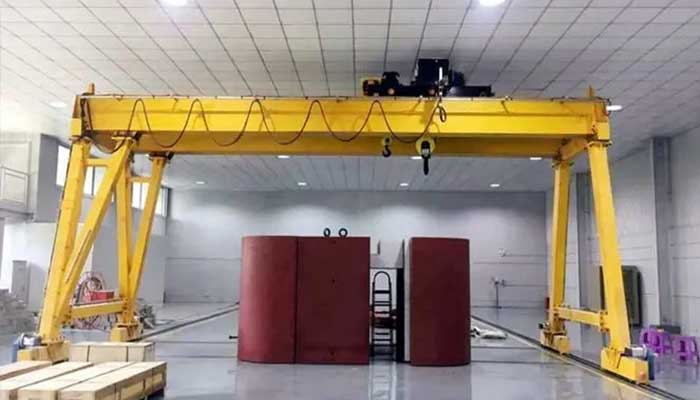
Environment:
- Indoor gantry cranes are designed for use inside enclosed structures such as manufacturing facilities, warehouses, and workshops.
- They are protected from exposure to the elements, making them suitable for indoor applications.
Common Uses:
- Material Handling: Indoor gantry cranes are commonly used for the efficient movement of materials within a facility. They can lift and transport loads between workstations, assembly lines, and storage areas.
- Manufacturing: These cranes play a vital role in manufacturing processes, aiding in tasks such as assembling, welding, and positioning heavy components.
- Warehousing: Indoor gantry cranes are used in warehousing to manage inventory, load and unload products, and stack goods on high shelves.
- Maintenance: They are valuable for maintenance and repair operations, allowing for the precise positioning of equipment and machinery.
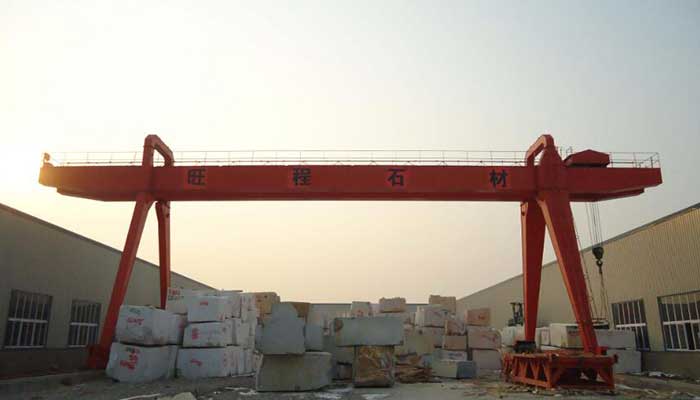
Environment:
- Outdoor gantry cranes are designed to operate in open-air environments, such as construction sites, shipping yards, and container terminals.
- They are exposed to weather conditions, including rain, wind, and varying temperatures, and are built to withstand these elements.
Common Uses:
- Construction: Outdoor gantry cranes are frequently used in construction projects for lifting and placing heavy materials, such as steel beams, concrete blocks, and equipment.
- Shipping and Container Handling: They are essential for loading and unloading cargo containers from ships and trucks in ports and intermodal facilities.
- Transportation: These cranes are used in railway maintenance yards for handling train cars, and in road construction projects to move heavy materials.
- Mining: Outdoor gantry cranes are employed in mining operations to hoist and transport materials and equipment in rugged outdoor environments.
Key Differences:
- Environment: The most significant difference is the operating environment. Indoor gantry cranes operate within enclosed spaces, while outdoor gantry cranes work in open-air settings.
- Weather Resistance: Outdoor gantry cranes are built to withstand exposure to the elements, with weather-resistant features such as rust-resistant coatings and durable materials.
- Applications: Each type of gantry crane is tailored to specific applications, with indoor cranes primarily used for material handling within a facility and outdoor cranes for heavy-duty, open-air applications.
- Mobility: Outdoor gantry cranes may have additional mobility features, such as wheels or tracks, to facilitate movement across rough terrain.
Both indoor and outdoor gantry cranes serve crucial roles in a variety of industries, enabling efficient material handling and lifting operations. The choice between them depends on the specific needs of the application and the environmental conditions in which they will operate.
Specialized Gantry Cranes for Unique Applications
Container Gantry Cranes:
- Description: Container gantry cranes, also known as port cranes, are designed for the efficient loading and unloading of shipping containers from vessels. They are often massive and can reach remarkable heights.
- Ideal for: Container gantry cranes are a common sight in seaports and container terminals, where they handle the rapid transfer of containers from ships to storage areas.
- Benefits: These cranes play a pivotal role in global trade, ensuring the smooth flow of goods in and out of ports.
Aerospace Gantry Cranes:
- Description: Aerospace gantry cranes are customized to accommodate the unique needs of the aerospace industry. They are built to handle aircraft components, engines, and assemblies with precision.
- Ideal for: Aerospace gantry cranes are commonly found in aircraft manufacturing facilities, maintenance and repair operations, and testing facilities.
- Benefits: These specialized cranes support the intricate processes of building and maintaining aircraft, ensuring safety and accuracy.
Understanding the distinctions between these types of overhead gantry cranes is vital in selecting the right equipment to optimize your operations and meet your specific material handling requirements.
Key Features and Components
When it comes to overhead gantry cranes, understanding the key features and components is essential for efficient and safe operation. Let's explore these crucial elements in detail:
Hoist Mechanism
The hoist mechanism is the heart of any gantry crane, responsible for lifting and lowering heavy loads. Gantry cranes can be equipped with various types of hoists, including:
- Electric Chain Hoists: These are versatile and cost-effective, suitable for a wide range of lifting tasks. They are known for their reliability and durability.
- Wire Rope Hoists: Wire rope hoists offer higher load capacity and are often used in heavy-duty applications. They are robust and can withstand intense working conditions.
- Air Hoists: Air hoists are preferred in environments where electrical equipment poses safety concerns, such as explosive or hazardous locations.
- Specialized Hoists: Some applications require specialized hoists, such as magnet hoists for lifting ferrous materials or explosion-proof hoists for hazardous environments.
Trolley
The trolley is a component that allows horizontal movement along the gantry crane's bridge. It is crucial for positioning loads precisely. There are two main types of trolleys:
- Manual Trolleys: These are operated by hand, typically using a chain or rope. They are cost-effective and suitable for lighter loads and applications that do not require frequent horizontal movement.
- Electric Trolleys: Electric trolleys are motorized, offering more precise and efficient lateral motion. They are ideal for heavy loads and applications that require frequent repositioning.
Bridge Structure
The bridge structure forms the horizontal framework of the gantry crane. It typically consists of two horizontal girders supported by the vertical legs. The choice of bridge structure (single or double girder) depends on the crane's intended use. Double girder gantry cranes offer more load-bearing capacity and stability for heavy-duty applications, while single girder cranes are more cost-effective and suitable for lighter loads.
Electrical Systems and Controls
Modern overhead gantry cranes are equipped with advanced electrical systems and controls to ensure safe and efficient operation. These systems include:
- Radio Remote Controls: These allow operators to control the crane remotely, offering flexibility and enhancing safety.
- Variable Frequency Drives (VFDs): VFDs provide precise control over crane movement, enabling smooth acceleration and deceleration.
- Limit Switches: Limit switches prevent the crane from over-traveling, enhancing safety and protecting equipment from damage.
- Emergency Stop Buttons: These are essential safety features that can quickly halt crane operations in case of emergencies.
- Load and Weight Measurement Systems: Some cranes are equipped with load cells and sensors to accurately measure and display the weight of the load being lifte
Safety Features
Safety is paramount in gantry crane operation. These cranes are equipped with various safety features and mechanisms, including:
- Overload Protection: Overload protection systems ensure that the crane does not exceed its rated load capacity, preventing accidents and equipment damage.
- Emergency Braking Systems: These systems engage in case of power loss or other emergencies to stop the crane and prevent accidents.
- Anti-Collision Systems: Some cranes have anti-collision systems that use sensors to detect obstacles and prevent collisions.
- Warning Lights and Audible Alarms: These alert workers to the crane's movement and operation, enhancing overall safety.
Understanding these key features and components is essential for both crane operators and those considering the purchase of an overhead gantry crane. It ensures that the crane is used safely and effectively, leading to increased efficiency and reduced downtime.
Overhead Gantry Crane Manufacturers
Selecting the right manufacturer for your overhead gantry crane is a crucial decision. The manufacturer you choose can greatly impact the quality, durability, and reliability of your equipment. In this section, we'll explore the world of gantry crane manufacturers, what to consider when choosing one, and where to find overhead gantry cranes for sale.
Leading Manufacturers in the Industry
Several reputable manufacturers are known for producing high-quality overhead gantry cranes. Here are some of the leading names in the industry:
- Demag: Demag is a globally recognized manufacturer with a long history of producing overhead cranes known for their precision and durability. They offer a wide range of gantry cranes tailored to various applications.
- Konecranes: Konecranes is a well-respected manufacturer with a global presence. They provide a variety of overhead gantry cranes and offer customization options to meet specific requirements.
- Gorbel: Gorbel is known for its innovative and ergonomic material handling solutions. They offer a range of gantry cranes designed for efficiency and safety in various industries.
- Spanco: Spanco manufactures gantry cranes and workstation bridge cranes that are designed for versatile and reliable lifting solutions. They are known for their excellent customer support and service.
- Street Crane: Street Crane is a UK-based manufacturer that produces a wide range of overhead cranes, including gantry cranes, known for their quality and performance.
Factors to Consider When Choosing a Manufacturer
When selecting a manufacturer for your overhead gantry crane, there are several important factors to consider:
- Reputation: Research the manufacturer's reputation in the industry. Look for reviews, testimonials, and case studies to gauge their track recor
- Customization Options: Assess whether the manufacturer can customize a gantry crane to suit your specific needs and workspace.
- Warranty and Support: Inquire about the warranty and after-sales support provided by the manufacturer. A strong warranty and responsive customer support are invaluable.
- Compliance: Ensure that the manufacturer adheres to relevant safety and quality standards. This ensures that your crane will meet industry regulations and safety requirements.
- Cost and Budget: Consider your budget and compare quotes from multiple manufacturers. Keep in mind that the lowest price may not always equate to the best value.
Overhead Gantry Crane for Sale: Where to Find Them
If you're looking to purchase an overhead gantry crane, there are several avenues to explore:
- Directly from Manufacturers: Contacting manufacturers directly is an excellent way to discuss your specific requirements and explore the options they offer. They can provide detailed information on available models, pricing, and customization possibilities.
- Authorized Dealers: Many manufacturers have authorized dealers or distributors who can provide expert guidance and support in choosing the right crane for your needs.
- Online Marketplaces: Online marketplaces like Alibaba, eBay, and Amazon often have listings for overhead gantry cranes. Be sure to research sellers and verify product details before making a purchase.
- Auctions and Used Equipment Dealers: You can find both new and used gantry cranes at industrial equipment auctions and dealers specializing in pre-owned machinery.
- Local Suppliers: Explore local suppliers and equipment rental companies that may offer gantry cranes for sale or rent, along with maintenance and support services.
Careful consideration of your needs, a thorough assessment of manufacturers, and diligent research into sources for purchasing gantry cranes will help you make an informed decision and find the right equipment for your material handling requirements.
Overhead Gantry Crane Systems
Overhead gantry cranes are not standalone pieces of equipment but integral parts of larger systems. In this section, we'll explore the integration of gantry crane systems with warehouse and industrial operations, the role of automation and smart technologies, and the numerous advantages these systems offer.
Integration with Warehouse and Industrial Systems
- Optimizing Material Flow: Gantry crane systems play a pivotal role in optimizing material flow within warehouses and industrial facilities. Their ability to swiftly and precisely move heavy loads enables efficient stock handling, reducing bottlenecks and improving productivity.
- Seamless Workflow:Gantry crane systems are seamlessly integrated into existing warehouse and industrial systems. They can be customized to work in harmony with conveyor belts, storage racks, and assembly lines, ensuring that materials move through the production process smoothly.
- Just-in-Time Inventory:By facilitating efficient material handling, gantry crane systems enable just-in-time inventory management. This results in reduced storage costs, minimized excess inventory, and enhanced cost efficiency.
Automation and Smart Technologies
- Remote Operation:Modern gantry crane systems often feature remote operation capabilities. Operators can control the crane from a safe distance, improving both safety and efficiency.
- RFID Tracking:Some gantry crane systems are equipped with RFID (Radio-Frequency Identification) tracking, allowing for precise tracking and tracing of materials. This technology enhances inventory management and reduces the risk of errors.
- Predictive Maintenance:Automation and smart technologies enable predictive maintenance for gantry crane systems. Sensors can monitor the condition of critical components and alert maintenance personnel to issues before they result in downtime, reducing maintenance costs and improving uptime.
- Load Monitoring:Load measurement systems integrated into the crane can provide real-time data on the weight and balance of the load, ensuring safe and precise handling.
Advantages of Overhead Gantry Crane Systems
- Enhanced Productivity:Gantry crane systems can significantly boost productivity by speeding up material handling, reducing manual labor requirements, and minimizing production downtime.
- Cost Savings:These systems lead to cost savings by reducing labor expenses, optimizing inventory management, and minimizing the risk of accidents and product damage.
- Versatility:Gantry crane systems are versatile and adaptable to different industries and applications. They can be customized to suit specific operational requirements.
- Space Efficiency:Gantry crane systems are space-efficient, as they do not require extensive floor space or vertical supports. This is particularly advantageous in facilities with limited space.
- Safety:Safety features integrated into gantry crane systems, along with the use of automation, contribute to a safer working environment for employees.
- Higher Throughput:Gantry crane systems can handle high throughput efficiently, making them suitable for applications with high material handling demands.
- Reduced Product Damage:The precision and control offered by gantry crane systems result in reduced product damage, particularly when handling fragile or sensitive materials.
Incorporating overhead gantry crane systems into your industrial operations can lead to significant improvements in productivity, safety, and cost-efficiency. With advancements in automation and smart technologies, these systems are becoming even more integral in modern manufacturing and warehousing environments.
Overhead Gantry Crane Price
Understanding the pricing of overhead gantry cranes is crucial for making an informed purchase decision. In this section, we'll delve into the factors that affect the pricing of these cranes, considerations for budgeting, and the importance of a cost vs. benefits analysis.
Factors Affecting Pricing
The cost of an overhead gantry crane can vary significantly based on several key factors:
- Load Capacity: The crane's load capacity is a major determinant of its price. Higher load capacities typically require more robust components, resulting in a higher cost.
- Span: The span, or the distance between the crane's legs, affects its pricing. A wider span requires longer girders and may also need additional support structures, increasing the overall cost.
- Lift Height: The height to which the crane needs to lift materials impacts the price. Taller cranes may require longer vertical support structures and stronger components, adding to the cost.
- Hoist Mechanism: The type of hoist mechanism chosen, such as electric chain hoists, wire rope hoists, or specialized hoists, can significantly affect the crane's price.
- Customization: Customized features or specialized requirements, such as unique trolley designs, specialized controls, or specific safety features, can add to the overall cost.
- Manufacturer: Different manufacturers may offer similar crane configurations at varying price points. Reputation, quality, and additional services can influence pricing.
- Automation: The level of automation, including features like remote operation or smart technologies, can impact the cost of the crane.
Budget Considerations
When budgeting for an overhead gantry crane, it's essential to consider both the initial purchase cost and the long-term expenses. Here are some budget considerations:
- Purchase Price: Allocate a budget for the initial purchase of the gantry crane. Ensure it covers not only the crane itself but also any additional equipment, such as trolleys and hoists.
- Installation Costs: Factor in the cost of installation, including any required modifications to your facility, such as support structures or electrical work.
- Maintenance and Repairs: Budget for ongoing maintenance and potential repairs to keep the crane in good working condition.
- Operator Training: Training for crane operators should also be included in the budget to ensure safe and efficient operation.
- Utilities: Consider the increase in utility costs associated with operating an overhead gantry crane, such as electricity and maintenance.
- Insurance: Depending on the value of the crane and your specific needs, insurance costs can be a significant budget item.
- Replacement and Upgrades: Over time, you may need to budget for the replacement of certain components or the upgrading of the crane to meet changing requirements.
Cost vs. Benefits Analysis
Before finalizing your decision to purchase an overhead gantry crane, it's essential to conduct a thorough cost vs. benefits analysis:
- Benefits: Identify the benefits your organization will gain from the crane, such as increased productivity, improved safety, and reduced labor costs.
- Costs: Consider all costs associated with the crane, including the initial purchase, installation, ongoing maintenance, and operating expenses.
- Return on Investment (ROI): Calculate the potential ROI by comparing the benefits to the costs over the crane's expected lifespan. This will help determine if the investment is financially justifie
- Long-Term Viability: Assess the crane's ability to meet your needs in the long run. Will it adapt to changing requirements and continue to provide value?
- Safety and Compliance: Consider the cost of ensuring the crane's safety and compliance with regulations, which can prevent accidents and fines.
A well-considered budget and cost vs. benefits analysis will help you make an informed decision when purchasing an overhead gantry crane. By weighing the initial costs against the long-term advantages, you can determine whether the investment aligns with your organization's goals and financial objectives.
Overhead Gantry Hoist
The hoist is a critical component of an overhead gantry crane, and understanding its importance, different types, and maintenance and safety considerations is essential for smooth and safe crane operations.
Importance of the Hoist in Crane Operations
- Lifting and Lowering Loads:The hoist mechanism is responsible for lifting and lowering heavy loads. It provides the crane with its primary function and is the workhorse of the system.
- Precision Control:The hoist allows for precise control over the vertical movement of the loa This precision is crucial when positioning materials, especially in applications where accuracy is paramount.
- Load Capacity:The hoist's load capacity is a determining factor in the crane's overall capacity. It must be capable of safely lifting the heaviest loads the crane is designed for.
- Safety:A properly functioning hoist is essential for safety. Hoists are equipped with safety features to prevent overloading and ensure safe operation.
- Efficiency:An efficient hoist mechanism can improve productivity and reduce operational costs by speeding up the lifting and lowering of materials.
Hoist Types and Variations
There are several hoist types and variations available for overhead gantry cranes, each suited for different applications and load requirements:
- Compact and versatile. Ideal for light to moderate loads.
- Offers precise control and smooth lifting.
- Commonly used in manufacturing, assembly lines, and maintenance.
- Suitable for heavy-duty applications.
- Offer high load capacity and durability.
- Ideal for industries like shipbuilding, steel mills, and construction.
- Operate using compressed air, making them suitable for hazardous environments.
- Lightweight and easy to handle.
- Commonly used in chemical plants, foundries, and explosive atmospheres.
- Designed for use in hazardous or explosive environments.
- Ensures safety by preventing sparks or ignition sources.
- Common in petrochemical, mining, and offshore industries.
Maintenance and Safety Considerations
- Regular Inspection:Conduct routine inspections of the hoist to check for signs of wear, damage, or malfunction. Replace or repair any faulty components immediately.
- Lubrication:Regularly lubricate moving parts to reduce friction and wear, ensuring smooth and efficient hoist operation.
- Training and Certification:Ensure that crane operators are properly trained and certified to use the hoist safely and efficiently.
- Safety Features:Familiarize yourself with the hoist's safety features, such as overload protection and emergency stop functions. Always use these features when necessary.
- Compliance:Ensure that the hoist and crane system meet all relevant safety and operational regulations. Non-compliance can result in accidents, injuries, and fines.
- Records and Documentation:Maintain detailed records of hoist inspections, maintenance, and repairs. This documentation can be invaluable for safety audits and compliance.
- Emergency Procedures:Establish clear emergency procedures for situations like power failures or malfunctioning hoists to ensure the safety of personnel and equipment.
Proper maintenance and safety considerations regarding the hoist are critical to maintaining a safe and efficient overhead gantry crane system. Regular inspections, adherence to safety protocols, and the use of appropriate hoist types are essential for accident prevention and optimal crane performance.
Overhead Gantry System
Expanding an overhead gantry crane system with multiple cranes offers numerous advantages, including improved efficiency and productivity. In this section, we'll explore the benefits of expanding your system, real-world case studies, and applications.
Expanding Your System with Multiple Cranes
- Load Distribution:Multiple cranes can distribute the load more evenly, reducing strain on individual cranes and prolonging their lifespan.
- Parallel Workstations:When you have multiple cranes, you can set up parallel workstations, allowing for simultaneous handling of different materials or processes. This streamlines operations and reduces waiting times.
- Redundancy:Having multiple cranes offers redundancy. If one crane needs maintenance or encounters an issue, others can continue operations, minimizing downtime.
- Flexibility:You can adapt your operations to changing demands by deploying multiple cranes to different areas as neede This flexibility is valuable in dynamic industrial settings.
Efficiency and Productivity Benefits
- Increased Throughput: Multiple cranes can significantly increase the throughput of materials, allowing for more efficient operations and higher production rates.
- Reduced Wait Times: Parallel crane operations reduce wait times, leading to faster processing of materials and improved overall efficiency.
- Precise Load Control: With multiple cranes, you can achieve highly precise load control, which is crucial in applications where accuracy is vital.
- Optimized Workflows:Parallel crane operations allow for optimized workflows, reducing the risk of bottlenecks and enhancing overall efficiency.
Case Studies and Applications
- Automotive Manufacturing:In the automotive industry, multiple gantry cranes are used for efficient assembly line operations. They handle vehicle chassis, engines, and other components simultaneously, ensuring a continuous workflow.
- Steel Mills:Steel mills utilize multiple cranes for handling heavy and bulky steel products. Cranes work in unison to transport materials from the furnace to processing and storage areas.
- Warehousing:Large warehouses with high shelves often employ multiple gantry cranes to handle inventory efficiently. This approach ensures timely order fulfillment and minimizes the risk of material damage.
- Container Terminals:Container terminals at seaports use multiple gantry cranes for loading and unloading shipping containers from vessels. These cranes work in tandem to manage the high throughput of goods.
- Aircraft Manufacturing:Aircraft manufacturing facilities rely on multiple gantry cranes to assemble and move aircraft components with precision. These cranes support the intricate processes of building aircraft safely and efficiently.
The implementation of multiple overhead gantry cranes in various industries demonstrates the immense benefits of expanding your system. These real-world applications highlight how parallel crane operations can boost productivity, reduce wait times, and optimize workflows, ultimately enhancing operational efficiency and output.
Maintenance and Safety Guidelines
Maintaining the safety and efficiency of your overhead gantry crane is paramount. In this section, we'll delve into regular maintenance practices, safety protocols for users, and the importance of complying with regulations.
Regular Maintenance Practices
- Scheduled Inspections:Conduct regular scheduled inspections of the crane, including the hoist, trolley, and bridge structure. Inspect for signs of wear, corrosion, and potential issues.
- Lubrication:Regularly lubricate moving parts, such as bearings, gears, and pulleys, to minimize friction and wear. Follow the manufacturer's guidelines for the type and frequency of lubrication.
- Load Testing:Periodically perform load testing to ensure the crane's load capacity remains accurate and within safety limits. This can help detect issues with the hoist or other components.
- Electrical Systems:Inspect the electrical components, wiring, and controls for signs of damage or wear. Ensure proper grounding and electrical connections.
- Safety Features:Verify that all safety features, including limit switches, emergency stops, and overload protection, are in good working order.
- Documentation:Maintain detailed records of inspections, maintenance, and any repairs performed on the crane. This documentation is invaluable for safety audits and regulatory compliance.
Safety Protocols for Overhead Gantry Crane Users
- Operator Training:Ensure that all crane operators are properly trained and certifie Training should cover safe operation, emergency procedures, and understanding the crane's controls and safety features.
- Safe Loading Practices:Train operators to calculate loads accurately and secure them properly. Overloading the crane is a significant safety hazar
- Clear Communication:Establish clear and concise communication methods between the crane operator and ground personnel. Use signals or communication devices to ensure everyone is on the same page during lifting and moving operations.
- Safe Working Zone:Maintain a designated safe working zone around the crane to prevent unauthorized personnel from entering the area during operations. Use barriers or visual cues to demarcate this zone.
- Personal Protective Equipment (PPE):Ensure that all personnel working around the crane wear the necessary PPE, including hard hats, safety vests, and gloves, to protect against potential hazards.
Compliance with Regulations
- OSHA and Industry Standards:Familiarize yourself with the regulations and industry standards related to overhead gantry crane safety, such as those provided by the Occupational Safety and Health Administration (OSHA) in the United States.
- Regular Audits:Periodically conduct safety audits to assess compliance with regulations and standards. Address any non-compliance issues promptly.
- Permitting and Licensing:Ensure that your crane and operators comply with all required permits and licenses. This may include specialized permits for specific types of cranes or operations.
- Third-Party Inspections:Engage third-party inspectors to conduct impartial assessments of your crane's safety and compliance with regulations. Their expertise can provide valuable insights and recommendations.
By implementing regular maintenance practices, adhering to safety protocols, and complying with regulations, you can maintain a safe and efficient overhead gantry crane system. Prioritizing safety not only protects personnel but also contributes to the longevity of your equipment and the smooth functioning of your operations.
Wrap it Up
As we conclude our comprehensive exploration of overhead gantry cranes, we recap the essentials, provide final tips for buyers and users, and encourage informed decision-making.
Definition and importance of overhead gantry cranes.
- Types of overhead gantry cranes, such as single vs. double girder cranes and specialized models.
- Key components like hoist mechanisms, trolleys, and safety features.
- The role of manufacturers, their reputation, and factors to consider when choosing one.
- Pricing factors, budget considerations, and the importance of a cost vs. benefits analysis.
- The importance of the hoist in crane operations and its various types.
- Maintenance and safety guidelines for crane operators and organizations.
- The advantages of expanding your system with multiple cranes.
- Case studies showcasing real-world applications of overhead gantry crane systems.
- Safety and compliance considerations for your equipment.
Final Tips for Buyers and Users
- Prioritize safety: Safety should always be the top priority. Ensure your operators are well-trained and compliant with safety protocols and regulations.
- Choose the right crane type: Select a crane that aligns with your specific needs, whether it's for light, moderate, or heavy-duty applications.
- Maintenance is key: Regular maintenance and inspections are essential to keep your crane in good working condition. This not only extends its lifespan but also ensures safety.
- Invest wisely: When purchasing an overhead gantry crane, consider long-term benefits, not just the initial cost. Look for a crane that offers a good balance of efficiency and reliability.
Encouragement for Informed Decision-Making
We encourage all buyers and users of overhead gantry cranes to make informed decisions. Consider the unique needs and challenges of your industry and applications. Evaluate your budget, safety measures, and compliance requirements. Take the time to research manufacturers, their reputations, and the crane's specific features. Don't hesitate to seek expert advice and guidance when making your selection.
By staying informed and making well-considered choices, you can maximize the efficiency and safety of your operations, ultimately leading to increased productivity and a positive impact on your bottom line. Overhead gantry cranes are valuable assets in a variety of industries, and your investment in the right crane can contribute to your organization's success.
Main Projects
Related Products
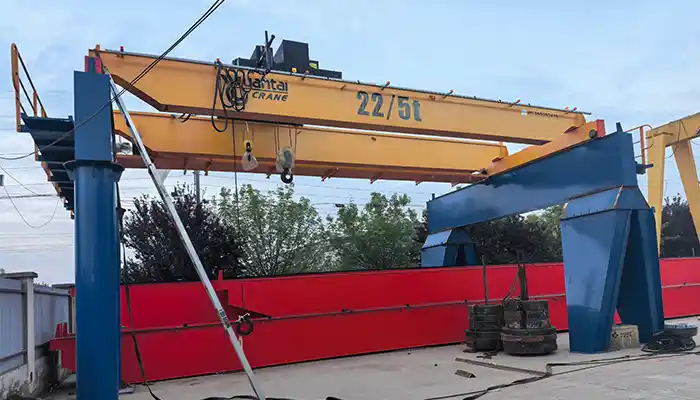
22/5 Ton Overhead Crane Double Hook System: Robust double girder crane with 22-ton main and 5-ton auxiliary hooks for heavy lifting. Get double hook crane!
Free consultation to Confirm Parameters & Specifications and Get
Latest Crane Price & Crane Rate.
- Types of overhead cranes : _______?
- Optional: Overhead travelling crane, goliath gantry crane,Slewing jib crane, Single girder or double girder crane,small portable crane or kbk crane, etc.
- Capacity of overhead crane: _______?
- Optional: 0.25ton, 0.5 ton, 1 ton, 2 ton, 3ton, 5 ton, 10 ton,15ton, 20ton, 25 ton, 30ton,35ton, up to 550ton, etc.
- Crane span & lifting height : _______?
- Crane travelling length : _____?
- Control of overhead crane:_______?
- Optional: pendant/ remote/cabin control
- Voltage supply of overhead crane:_____?
- Eg,: 380V50/60HZ,3Phase or others,etc.
- Application/usage of crane:_______?
- Eg,: Steel mill, ,injection mold, cement,stone, concrete,granite, general manufacturing, etc.
Just leave a message via the contact form and our hoist and crane engineer will contact you with in 24working hours.
Get In Touch
